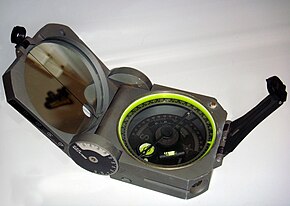
Back اتجاه زاوي Arabic Пеленг Bulgarian Rumb Catalan Kurs Danish Peilung German Διόπτευση Greek Birilo Esperanto Rumbo Spanish Kurss Estonian Relèvement French

In navigation, bearing or azimuth is the horizontal angle between the direction of an object and north or another object. The angle value can be specified in various angular units, such as degrees, mils, or grad. More specifically:
- Absolute bearing refers to the clockwise angle between the magnetic north (magnetic bearing) or true north (true bearing) and an object. For example, an object to due east would have an absolute bearing of 90 degrees. Thus, it is the same as azimuth.[1]
- Relative bearing refers to the angle between the craft's forward direction (heading) and the location of another object. For example, an object relative bearing of 0 degrees would be immediately in front; an object relative bearing 180 degrees would be behind.[2] Bearings can be measured in mils, points, or degrees. Thus, it is the same as an azimuth difference (modulo +/- 360 degrees).
Alternatively, the US Army defines the bearing from point A to point B as the smallest angle between the ray AB and either north or south, whichever is closest. The bearing is expressed in terms of 2 characters and 1 number: first, the character is either N or S; next is the angle numerical value; third, the character representing the perpendicular direction, either E or W. The bearing angle value will always be less than 90 degrees.[1] For example, if Point B is located exactly southeast of Point A, the bearing from Point A to Point B is "S 45° E".[3] For example, if the bearing between Point A and Point B is S 45° E, the azimuth between Point A and Point B is 135°.[1][3]

- ^ a b c U.S. Army, Advanced Map and Aerial Photograph Reading, Headquarters, War Department, Washington, D.C. (17 September 1941), pp. 24-25 [1]
- ^ Rutstrum, Carl (2000). The Wilderness Route Finder. University of Minnesota Press. p. 194. ISBN 0-8166-3661-3.
- ^ a b U.S. Army, Map Reading and Land Navigation, FM 21-26, Headquarters, Dept. of the Army, Washington, D.C. (28 March 1956), ch. 3, pp. 69-70